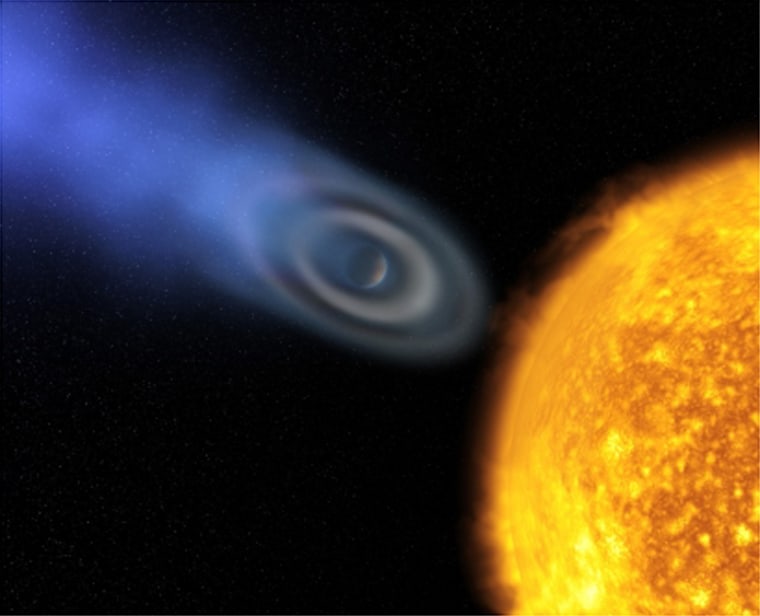Astronomers have detected the first presence of oxygen and carbon in the atmosphere of an extrasolar planet, a world already known to be venting massive amounts of gas into space.
The find is evidence of an atmospheric "blowoff" in action, where energetic hydrogen gas drags heavier elements along for a supersonic ride into space.
"If you imagine a wind so efficient that it takes everything with it, sand particles for instance, you get the idea," said the study's leader, Alfred Vidal-Madjar of the Institut d'Astrophysique de Paris. The planet "is really losing a lot of material even more efficiently than we thought before."
Despite the oxygen, the faraway planet is not one that would support life.
DismemberingThe Jupiterlike planet is officially called HD 209458b, though Vidal-Madjar's team has nicknamed it Osiris after an Egyptian god who was dismembered by his brother Seth. It orbits a sunlike star 150 light-years from Earth.
Astronomers already knew the planet was rapidly losing its atmosphere after a led by Vidal-Madjar found it spewing out enough hydrogen gas to create an envelope that extended and trailed the extrasolar world.
The planet was thought to be losing at least 10,000 tons of material each second, but researchers weren't sure the process was powerful enough to dredge up heavier elements.
Carbon and oxygen atoms are 10 times heavier than those of hydrogen, and therefore would normally lie low in a planet's atmosphere, explained Gilda Ballester, a University of Arizona astronomer who took part in the study. "So a force stronger than gravity is driving them up along with the hydrogen gas into the extended envelope around this planet," she said.
The venting process has been attributed to a pair of reasons, namely the intense gravitational forces between the planet and its parent star, as well as the super-hot temperature of the planet's atmosphere. HD 209458b circles its stellar parent every 3.5 days from a distance of just 4.4 million miles (7 million kilometers), which is closer than Mercury's orbit around the sun.
The hydrogen wind erupts away from the planet like a geyser and is powerful enough to sweep up carbon and oxygen with it.
The planet may eventually shed its entire atmosphere, leaving behind only a solid core remnant of its once massive self. The unique nature of this process has led Vidal-Madjar's team to propose the existence of a new class of extrasolar planets, one which may be populated by the remains of worlds that have shed their atmospheric skins and orbit even closer to their suns than HD 209458b.
The process is similar to one that may have eventually produced the atmospheres around more local planets, such as Venus and Earth, astronomers said.
"The composition of Earth's atmosphere today is so peculiar, that there must exist an efficient process that blew out much of the original material," Vidal-Madjar told Space.com. "Now we are directly observing it in Osiris."
The next step, Vidal-Madjar says, is to search for even heavier elements, such as iron, in the envelope around HD 209458b, which would go further in confirming the blowout process.
HD 209458b orbits a star in the constellation Pegasus, which can be seen with binoculars from the ground. The planet was first using the method of planet hunting. A separate team of astronomers previously detected in the planet's atmosphere as well.
